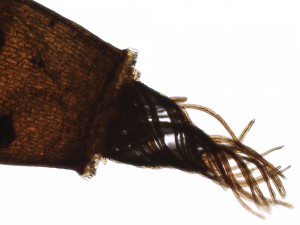Habitat
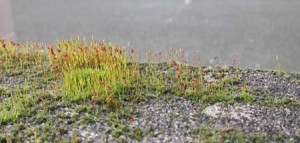 Tortula muralis is most commonly found growing in urban areas on concrete, but can also be seen growing on bark (uncommonly), on stones and on sandstone cliffs.
Tortula muralis is most commonly found growing in urban areas on concrete, but can also be seen growing on bark (uncommonly), on stones and on sandstone cliffs.
Gametophyte
Overall Structure:
 Tortula muralis has an acrocarpous growth habit, meaning the sporophyte is terminal on the main shoot apex. Clusters of Tortula muralis leaves have a whitish cast due to the awns on the end of leaves.
Tortula muralis has an acrocarpous growth habit, meaning the sporophyte is terminal on the main shoot apex. Clusters of Tortula muralis leaves have a whitish cast due to the awns on the end of leaves.
Leaf Structure:
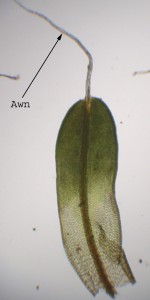 The leaf margin and costa are visibly differentiated from the lamina. The costa extends past the blade of the leaf to form a hairpoint or awn. The hairpoint resembles a long white hair at the apex of the leaf.
The leaf margin and costa are visibly differentiated from the lamina. The costa extends past the blade of the leaf to form a hairpoint or awn. The hairpoint resembles a long white hair at the apex of the leaf.
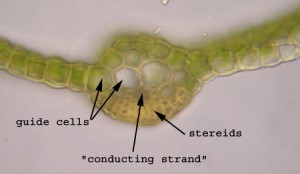 The multistratose leaf costa contains a central conducting strand, surrounded with guide cells and thick-walled stereids. There are no hydroids present in the leaves of Tortula muralis.
The multistratose leaf costa contains a central conducting strand, surrounded with guide cells and thick-walled stereids. There are no hydroids present in the leaves of Tortula muralis.
 The leaf lamina is unistratose and marginal cells are differentiated. A whole mount of a leaf may give the illusion that the leaf margins are multistratose; however, the margins are in actuality unistratose and recurved.
The leaf lamina is unistratose and marginal cells are differentiated. A whole mount of a leaf may give the illusion that the leaf margins are multistratose; however, the margins are in actuality unistratose and recurved.
 A closer view of the lamina in cross-section reveals that the laminal cells are papillose.
A closer view of the lamina in cross-section reveals that the laminal cells are papillose.
Protonema:
The protonemal stage is uniseriate, with transverse or oblique crosswalls depending on the level of maturation. Protonema contain chloroplasts, which is characteristically different from rhizoids.
Sporophyte
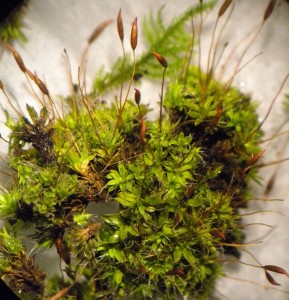 Sporophytes commonly mature in the spring and are red-brown at maturity. The setae are relatively tall compared to the gametophytes from which they emerge.
Sporophytes commonly mature in the spring and are red-brown at maturity. The setae are relatively tall compared to the gametophytes from which they emerge.
Sporangium:
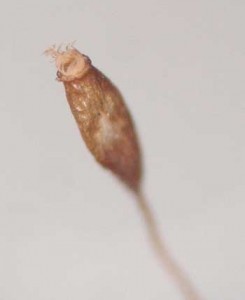 The sporangia are erect and cylindric shaped. The peristome teeth are composed of twisted filaments and are red in color.
The sporangia are erect and cylindric shaped. The peristome teeth are composed of twisted filaments and are red in color.
The peristome teeth are fused at the base and move hygroscopically, aiding with the dispersal of spores.
In common with other mosses, stomata are present at the base of the sporangium in this species.
Seta:
 The seta has a central conducting strand. Parenchymal cells surround the conducting strand. Outer thick-walled epidermal cells enclose the cortex of parenchymal cells.
The seta has a central conducting strand. Parenchymal cells surround the conducting strand. Outer thick-walled epidermal cells enclose the cortex of parenchymal cells.
Comments:
Along with Grimmia pulvinata, this is one of the most common and abundant acrocarpous mosses found growing on concrete surfaces in urban areas of Southwestern British Columbia.

